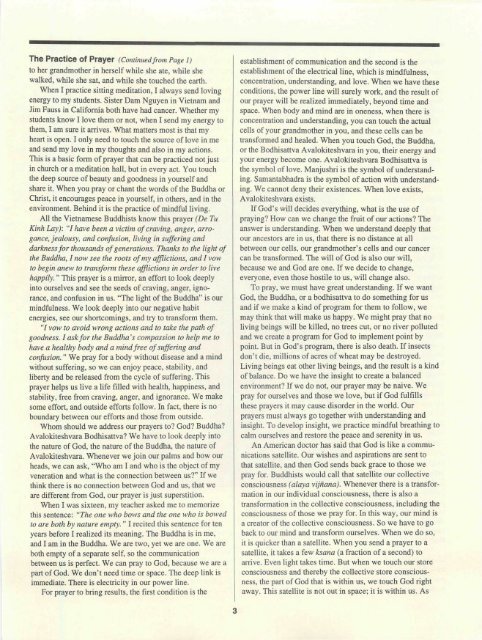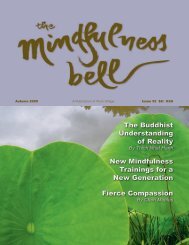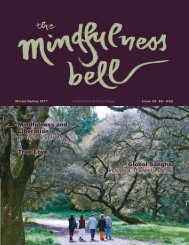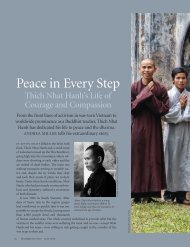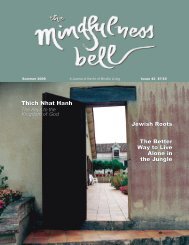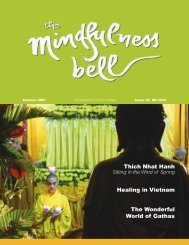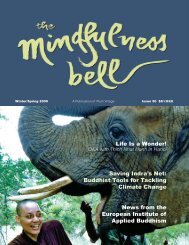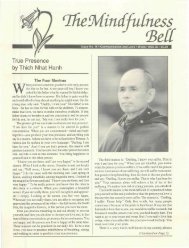The Practice of Prayer byThich Nhat Hanh - The Mindfulness Bell
The Practice of Prayer byThich Nhat Hanh - The Mindfulness Bell
The Practice of Prayer byThich Nhat Hanh - The Mindfulness Bell
Create successful ePaper yourself
Turn your PDF publications into a flip-book with our unique Google optimized e-Paper software.
<strong>The</strong> <strong>Practice</strong> Of <strong>Prayer</strong> (Continued fromPage1)<br />
to her grandmother in herself while she ate, while she<br />
walked, while she sat, and while she touched the earth.<br />
When I practice sitting meditation, I always send loving<br />
energy to my students. Sister Dam Nguyen in Vietnam and<br />
Jim Fauss in California both have had cancer. Whether my<br />
students know I love them or not, when I send my energy to<br />
them, Iam sure it arrives. What matters most is thatmy<br />
heart is open. I only need to touch the source <strong>of</strong> love inme<br />
and send my love in my thoughts and also inmy actions.<br />
This is a basic form <strong>of</strong> prayer that can be practiced not just<br />
in church or a meditation hall, but in every act. You touch<br />
the deep source <strong>of</strong> beauty and goodness in yourself and<br />
share it.When you pray or chant the words <strong>of</strong> the Buddha or<br />
Christ, it encourages peace in yourself, in others,and in the<br />
environment. Behind it is the practice <strong>of</strong> mindful living.<br />
All the Vietnamese Buddhists know this prayer (De Tu<br />
Kinh Lay): "I have been a victim <strong>of</strong> craving, anger, arrogance,<br />
jealousy, and confusion, living in suffering and<br />
darkness forthousands <strong>of</strong> generations. Thanks to the light <strong>of</strong><br />
the Buddha, I now see the roots <strong>of</strong> my afflictions, and I vow<br />
to begin anew to transform these afflictions in order to live<br />
happily." This prayer is a mirror, an effort to look deeply<br />
into ourselves and see the seeds <strong>of</strong> craving, anger, ignorance,and<br />
confusion in us. "<strong>The</strong> light <strong>of</strong> the Buddha" is our<br />
mindfulness. We look deeply into our negative habit<br />
energies, see our shortcomings, and try totransform them.<br />
"I vow to avoid wrong actions and to take the path <strong>of</strong><br />
goodness. I ask forthe Buddha's compassion to help me to<br />
have a healthy body and a mind free<strong>of</strong> suffering and<br />
confusion." We pray for a body without disease and amind<br />
without suffering, so wecan enjoy peace, stability, and<br />
liberty and be released from the cycle <strong>of</strong> suffering. This<br />
prayer helps us live a life filled with health, happiness,and<br />
stability, free from craving, anger, and ignorance. We make<br />
some effort, and outside efforts follow. In fact, there isno<br />
boundary between our efforts and those from outside.<br />
Whom should we address our prayers to? God? Buddha?<br />
Avalokiteshvara Bodhisattva? We have to look deeply into<br />
the nature <strong>of</strong> God, the nature <strong>of</strong> the Buddha, the nature<strong>of</strong><br />
Avalokiteshvara. Whenever we join our palms and bow our<br />
heads,wecan ask, "Who am I and who is the object <strong>of</strong>my<br />
veneration and what is the connection between us?"If we<br />
think there is no connection between God and us, that we<br />
aredifferent from God, our prayer is just superstition.<br />
When Iwas sixteen, my teacher asked me to memorize<br />
this sentence: "<strong>The</strong> one who bows and the one who is bowed<br />
to are both by nature empty. " Irecited this sentence for ten<br />
years before Irealized its meaning. <strong>The</strong> Buddha is in me,<br />
and Iam in the Buddha. We are two,yet we are one.We are<br />
both empty <strong>of</strong> a separate self, so the communication<br />
between us is perfect. We can pray to God, because we are a<br />
part <strong>of</strong> God. We don't need time or space. <strong>The</strong> deep link is<br />
immediate. <strong>The</strong>re is electricity in our power line.<br />
For prayer to bring results, the first condition is the<br />
establishment <strong>of</strong> communication and the second is the<br />
establishment <strong>of</strong> the electrical line, which is mindfulness,<br />
concentration, understanding, and love. When we have these<br />
conditions, the power line will surely work, and the result <strong>of</strong><br />
our prayer will be realized immediately, beyond time and<br />
space.When body and mind are in oneness, when there is<br />
concentration and understanding, you can touch the actual<br />
cells <strong>of</strong> your grandmother in you, and these cells can be<br />
transformed and healed. When you touch God, the Buddha,<br />
or the Bodhisattva Avalokiteshvara in you, their energy and<br />
your energy become one. Avalokiteshvara Bodhisattva is<br />
the symbol <strong>of</strong> love. Manjushri is the symbol <strong>of</strong> understanding.<br />
Samantabhadra is the symbol <strong>of</strong> action with understanding.We<br />
cannot deny their existences. When love exists,<br />
Avalokiteshvara exists.<br />
If God's will decides everything, what is the use <strong>of</strong><br />
praying? How can we change the fruit <strong>of</strong> our actions? <strong>The</strong><br />
answer is understanding. When we understand deeply that<br />
our ancestors are in us, that there is no distance at all<br />
between our cells, our grandmother's cells and our cancer<br />
can be transformed. <strong>The</strong> will <strong>of</strong> God is also our will,<br />
because weand God are one. If we decide to change,<br />
everyone, even those hostile to us, will change also.<br />
To pray, we must have great understanding. If we want<br />
God, the Buddha, or a bodhisattva to do something for us<br />
and if we make a kind <strong>of</strong> program for them to follow, we<br />
may think that will make us happy. We might pray that no<br />
living beings will be killed, no trees cut, or no river polluted<br />
and we create a program for God to implement point by<br />
point. But in God's program, there is also death. If insects<br />
don't die, millions <strong>of</strong> acres <strong>of</strong> wheat may be destroyed.<br />
Living beings eat other living beings, and the result is a kind<br />
<strong>of</strong> balance. Do we have the insight to create a balanced<br />
environment? If we do not, our prayer may be naive. We<br />
pray for ourselves and those we love, but if God fulfills<br />
these prayers it may cause disorder in the world. Our<br />
prayers must always go together with understanding and<br />
insight. To develop insight, we practice mindful breathing to<br />
calm ourselves and restore the peace and serenity in us.<br />
An American doctor has said that God is like a communications<br />
satellite. Our wishes and aspirations are sent to<br />
that satellite, and then God sends back grace to those we<br />
pray for. Buddhists would call that satellite our collective<br />
consciousness (alaya vijhana). Whenever there is a transformation<br />
in our individual consciousness, there is also a<br />
transformation in the collective consciousness, including the<br />
consciousness <strong>of</strong> those we pray for. In this way, our mind is<br />
a creator <strong>of</strong> the collective consciousness. So we have to go<br />
back to our mind and transform ourselves. When we do so,<br />
it is quicker than a satellite. When you send a prayer to a<br />
satellite, it takes afew ksana (a fraction <strong>of</strong> a second) to<br />
arrive. Even light takes time. But when we touch our store<br />
consciousness and thereby the collective store consciousness,<br />
the part <strong>of</strong> God that is within us, we touch God right<br />
away.This satellite is not out in space; it is within us. As<br />
3


